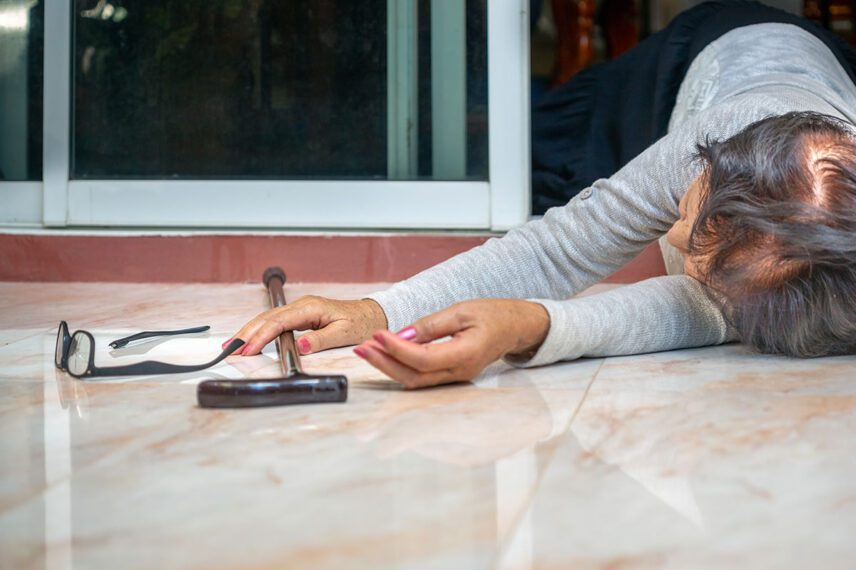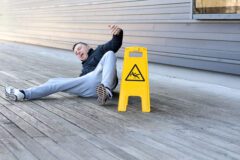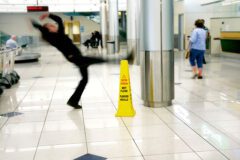How Much Compensation Can I Receive After An Injury?

Slip-and-fall accidents can happen to anyone. Imagine a person walking along a grocery aisle when they suddenly lose traction and come crashing onto the ground, breaking a hip in the process. Or perhaps they’re walking inside an office building when suddenly, they trip onto their face over a loose piece of carpeting lining the floor. Whatever the situation, when a slip-and-fall accident causes injury, a person is liable to file suit against the property owner.
Compensation for a slip-and-fall accident depends on various factors, and while there is no set amount for how much a person is entitled to, there are a few basic ways to calculate the amount your case might be worth. First, let’s go over some of the basics of slip-and-fall accidents.
Types of Injuries Caused by Slip-and-Falls
Slip-and-fall accidents can range in severity from life-threatening injuries to minor scrapes and bruises. Sometimes, negligence on behalf of the property owner is to blame. Other times, there is no responsible party. However, if a slip-and-fall accident occurs on hospital premises, at a business, or on government property, someone can be held liable if a degree of negligence contributed to the accident. Some of the types of injuries that can result from slip-and-falls include:
Hip Fractures
One of the most common injuries from slip-and-falls, this injury is prevalent in older patients. Hip fractures are expensive to treat and require extensive healing time to recover.
Head Injuries
Head injuries are one of the more severe injuries that can result from a slip-and-fall accident, including concussions and traumatic brain injuries. TBIs can cause seizures, cognitive impairment, and mood changes.
Spinal Cord and Back Injuries
Another injury that disproportionately affects older adults is spinal cord and back injuries that can lead to more severe injuries such as paralysis or neurologic impairments.
Sprains and Fractures
Sprains and fractures tend to occur by body parts attempting to brace the fall, such as wrists, ankles, hands, and hips. However, they can occur anywhere in the body and can cause serious harm to the connective tissues between bones and muscles.
Determining Damages in a Slip-and-Fall Case
Damages are any type of loss caused as a result of your injury. Two main types of damages occur as a result of a slip-and-fall incident:
Economic Damages
These include damages with a financial value directly attached to them, such as medical bills, lost work wages, and physical therapy costs.
Non-Economic Damages
Non-Economic damages do not have a value attached to them and include things like mental pain and suffering.
A third, less commonly awarded type of damage includes punitive damages, which are typically awarded as a form of punishment for the defendant and to prevent them from doing the same action again in the future.
To calculate the base amount of damages you are owed, add all economic damages together and multiply them by the degree of pain and suffering you believe you are owed (on a scale of 1.5 and 5). The total will predict the amount of compensation you may be entitled to, although a personal injury lawyer can calculate this amount with far better accuracy.
What is the Average Amount of a Slip-and-Fall Settlement?
As mentioned earlier, determining a slip-and-fall case’s value depends on several factors, especially the types of damages involved in an accident. However, the amount of evidence and the circumstances surrounding your incident can also affect the average payout. It’s tough to place a specific average value on slip-and-fall cases because each one is uniquely different, so putting any type of value on the average case will not indicate how much your case may be worth. The best way to determine how much compensation you are entitled to is to contact an experienced personal injury attorney.
Does Slip-and-Fall Compensation Vary by Business?
The short answer is yes; slip-and-fall compensation varies depending on where your accident occurs. For instance, many large commercial businesses have excellent insurance policies designed to protect them against potential lawsuits, which means they are typically able to pay more significant amounts to victims who win slip-and-fall lawsuits. According to the Normandie Law Firm, payouts from various chains can be near the following amounts:
Walmart and Sam’s Club
Accidents are a common occurrence, so both places have generous insurance policies. For cases involving more severe injuries, the average value can be between $450,000 and multi-million dollar values.
Target
Target also has a significant insurance policy and depending on the severity of injuries, larger cases have resulted in up to two million dollar settlements.
Supermarkets
Supermarket accidents are exceptionally common, and most supermarket chains have good accident coverage. Cases are typically valued around the $200,00 mark.
Shopping Malls
Settlements tend to range in value from around $250,000 to $800,000.
Office Buildings
Insurance coverage tends to be less comprehensive than more prominent retail places, so settlement values are worth less, ranging from around $300,000 to $500,000.
Conclusion
The amount your slip-and-fall case is worth depends on a wide variety of factors, including the severity of your injuries, the types of economic and non-economic damages you sustained, the amount of evidence for your case, and the kind of business where your injury occurred. Hiring an experienced and knowledgeable personal injury lawyer will allow you to gain the most accurate estimate of your case worth and give you the best chance to maximize your compensation.






